How to use this book: Intro
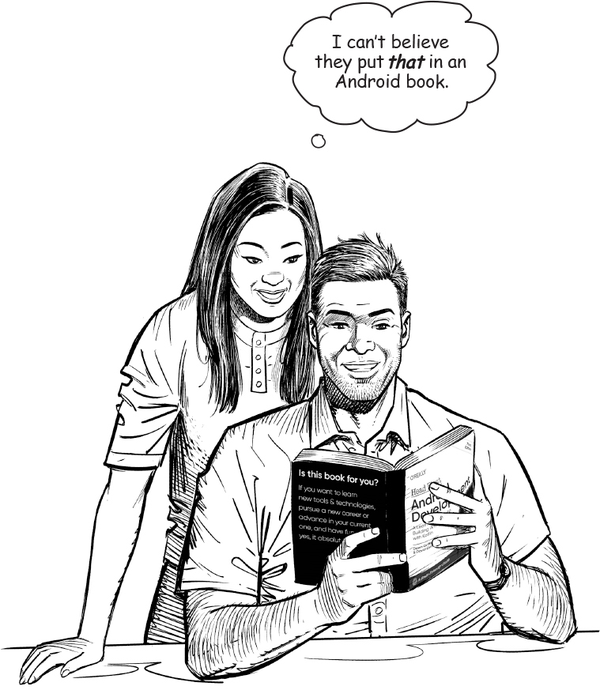
Note
In this section, we answer the burning question: âSo why DID they put that in a book on Android?â
Who is this book for?
If you can answer âyesâ to all of these:
Do you already know how to program in Kotlin, Java, or another object-oriented language?
Do you want to master Android app development, create the next big thing in software, make a small fortune, and retire to your own private island?
Note
OK, maybe that oneâs a little far-fetched. But, you gotta start somewhere, right?
Do you prefer actually doing things and applying the stuff you learn over listening to someone in a lecture rattle on for hours on end?
this book is for you.
Who should probably back away from this book?
If you can answer âyesâ to any of these:
Are you looking for a quick introduction or reference book to developing Android apps?
Would you rather have your toenails pulled out by 15 screaming monkeys than learn something new? Do you believe an Android book should cover everything, especially all the obscure stuff youâll never use, and if it bores the reader to tears in the process, then so much the better?
this book is not for you.

Note
[Note from Marketing: this book is for anyone with a credit card or a PayPal account]
We know what youâre thinking
âHow can this be a serious book on developing Android apps?â
âWhatâs with all the graphics?â
âCan I actually learn it this way?â
We know what your brain is thinking
Your brain craves novelty. Itâs always searching, scanning, waiting for something unusual. It was built that way, and it helps you stay alive.
So what does your brain do with all the routine, ordinary, normal things you encounter? Everything it can to stop them from interfering with the brainâs real jobârecording things that matter. It doesnât bother saving the boring things; they never make it past the âthis is obviously not importantâ filter.
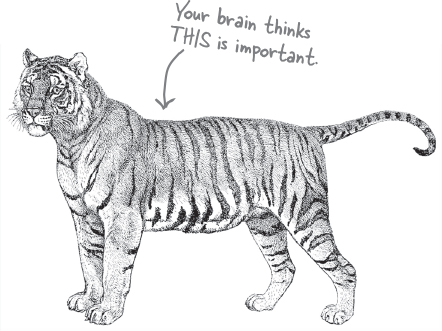
How does your brain know whatâs important? Suppose youâre out for a day hike and a tiger jumps in front of youâwhat happens inside your head and body?
Neurons fire. Emotions crank up. Chemicals surge.
And thatâs how your brain knowsâ¦
This must be important! Donât forget it!
But imagine youâre at home or in a library. Itâs a safe, warm, tiger-free zone. Youâre studying. Getting ready for an exam. Or trying to learn some tough technical topic your boss thinks will take a week, ten days at the most.
Just one problem. Your brainâs trying to do you a big favor. Itâs trying to make sure that this obviously unimportant content doesnât clutter up scarce resources. Resources that are better spent storing the really big things. Like tigers. Like the danger of fire. Like how you should never have posted those party photos on Instagram. And thereâs no simple way to tell your brain, âHey brain, thank you very much, but no matter how dull this book is, and how little Iâm registering on the emotional Richter scale right now, I really do want you to keep this stuff around.â
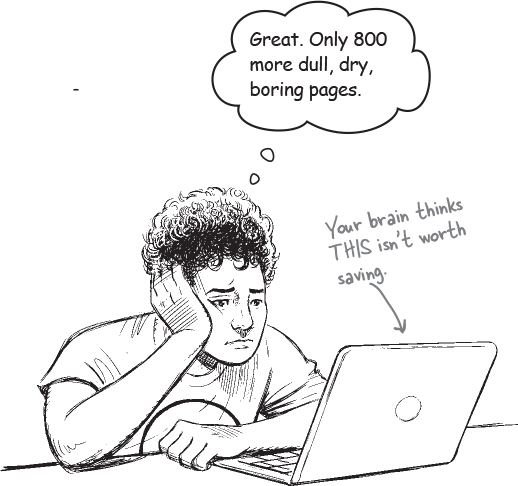
Metacognition: thinking about thinking
If you really want to learn, and you want to learn more quickly and more deeply, pay attention to how you pay attention. Think about how you think. Learn how you learn.
Most of us did not take courses on metacognition or learning theory when we were growing up. We were expected to learn, but rarely taught to learn.
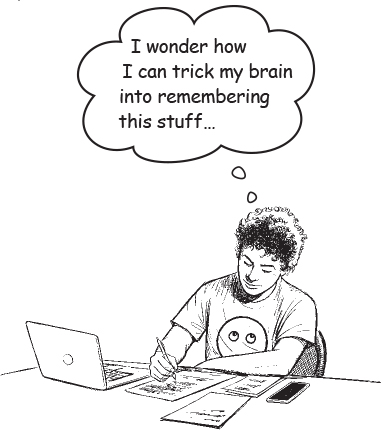
But we assume that if youâre holding this book, you really want to learn how to develop Android apps. And you probably donât want to spend a lot of time. If you want to use what you read in this book, you need to remember what you read. And for that, youâve got to understand it. To get the most from this book, or any book or learning experience, take responsibility for your brain. Your brain on this content.
The trick is to get your brain to see the new material youâre learning as Really Important. Crucial to your well-being. As important as a tiger. Otherwise, youâre in for a constant battle, with your brain doing its best to keep the new content from sticking.
So just how DO you get your brain to treat Android development like it was a hungry tiger?
Thereâs the slow, tedious way, or the faster, more effective way. The slow way is about sheer repetition. You obviously know that you are able to learn and remember even the dullest of topics if you keep pounding the same thing into your brain. With enough repetition, your brain says, âThis doesnât feel important to him, but he keeps looking at the same thing over and over and over, so I suppose it must be.â
The faster way is to do anything that increases brain activity, especially different types of brain activity. The things on the previous page are a big part of the solution, and theyâre all things that have been proven to help your brain work in your favor. For example, studies show that putting words within the pictures they describe (as opposed to somewhere else in the page, like a caption or in the body text) causes your brain to try to makes sense of how the words and picture relate, and this causes more neurons to fire. More neurons firing = more chances for your brain to get that this is something worth paying attention to, and possibly recording.
A conversational style helps because people tend to pay more attention when they perceive that theyâre in a conversation, since theyâre expected to follow along and hold up their end. The amazing thing is, your brain doesnât necessarily care that the âconversationâ is between you and a book! On the other hand, if the writing style is formal and dry, your brain perceives it the same way you experience being lectured to while sitting in a roomful of passive attendees. No need to stay awake.
But pictures and conversational style are just the beginningâ¦
Hereâs what WE did
We used pictures, because your brain is tuned for visuals, not text. As far as your brainâs concerned, a picture really is worth a thousand words. And when text and pictures work together, we embedded the text in the pictures because your brain works more effectively when the text is within the thing it refers to, as opposed to in a caption or buried in the body text somewhere.
We used redundancy, saying the same thing in different ways and with different media types, and multiple senses, to increase the chance that the content gets coded into more than one area of your brain.
We used concepts and pictures in unexpected ways because your brain is tuned for novelty, and we used pictures and ideas with at least some emotional content, because your brain is tuned to pay attention to the biochemistry of emotions. That which causes you to feel something is more likely to be remembered, even if that feeling is nothing more than a little humor, surprise, or interest.
We used a personalized, conversational style, because your brain is tuned to pay more attention when it believes youâre in a conversation than if it thinks youâre passively listening to a presentation. Your brain does this even when youâre reading.
We included activities, because your brain is tuned to learn and remember more when you do things than when you read about things. And we made the exercises challenging-yet-doable, because thatâs what most people prefer.
We used multiple learning styles, because you might prefer step-by-step procedures, while someone else wants to understand the big picture first, and someone else just wants to see an example. But regardless of your own learning preference, everyone benefits from seeing the same content represented in multiple ways.
We include content for both sides of your brain, because the more of your brain you engage, the more likely you are to learn and remember, and the longer you can stay focused. Since working one side of the brain often means giving the other side a chance to rest, you can be more productive at learning for a longer period of time.
And we included stories and exercises that present more than one point of view, because your brain is tuned to learn more deeply when itâs forced to make evaluations and judgments.
We included challenges, with exercises, and by asking questions that donât always have a straight answer, because your brain is tuned to learn and remember when it has to work at something. Think about itâyou canât get your body in shape just by watching people at the gym. But we did our best to make sure that when youâre working hard, itâs on the right things. That youâre not spending one extra dendrite processing a hard-to-understand example, or parsing difficult, jargon-laden, or overly terse text.
We used people. In stories, examples, pictures, etc., because, well, youâre a person. And your brain pays more attention to people than it does to things.
Hereâs what YOU can do to bend your brain into submission

Note
Cut this out and stick it on your refrigerator.
So, we did our part. The rest is up to you. These tips are a starting point; listen to your brain and figure out what works for you and what doesnât. Try new things.
Slow down. The more you understand, the less you have to memorize.
Donât just read. Stop and think. When the book asks you a question, donât just skip to the answer. Imagine that someone really is asking the question. The more deeply you force your brain to think, the better chance you have of learning and remembering.
Do the exercises. Write your own notes.
We put them in, but if we did them for you, that would be like having someone else do your workouts for you. And donât just look at the exercises. Use a pencil. Thereâs plenty of evidence that physical activity while learning can increase the learning.
Read âThere Are No Dumb Questions.â
That means all of them. Theyâre not optional sidebars, theyâre part of the core content! Donât skip them.
Make this the last thing you read before bed. Or at least the last challenging thing.
Part of the learning (especially the transfer to long-term memory) happens after you put the book down. Your brain needs time on its own, to do more processing. If you put in something new during that processing time, some of what you just learned will be lost.
Talk about it. Out loud.
Speaking activates a different part of the brain. If youâre trying to understand something, or increase your chance of remembering it later, say it out loud. Better still, try to explain it out loud to someone else. Youâll learn more quickly, and you might uncover ideas you hadnât known were there when you were reading about it.
Drink water. Lots of it.
Your brain works best in a nice bath of fluid. Dehydration (which can happen before you ever feel thirsty) decreases cognitive function.
Listen to your brain.
Pay attention to whether your brain is getting overloaded. If you find yourself starting to skim the surface or forget what you just read, itâs time for a break. Once you go past a certain point, you wonât learn faster by trying to shove more in, and you might even hurt the process.
Feel something.
Your brain needs to know that this matters. Get involved with the stories. Make up your own captions for the photos. Groaning over a bad joke is still better than feeling nothing at all.
Write a lot of code!
Thereâs only one way to learn to develop Android apps: write a lot of code. And thatâs what youâre going to do throughout this book. Coding is a skill, and the only way to get good at it is to practice. Weâre going to give you a lot of practice: every chapter has exercises that pose a problem for you to solve. Donât just skip over themâa lot of the learning happens when you solve the exercises. We included a solution to each exerciseâdonât be afraid to peek at the solution if you get stuck! (Itâs easy to get snagged on something small.) But try to solve the problem before you look at the solution. And definitely get it working before you move on to the next part of the book.
Read me
This is a learning experience, not a reference book. We deliberately stripped out everything that might get in the way of learning whatever it is weâre working on at that point in the book. And the first time through, you need to begin at the beginning, because the book makes assumptions about what youâve already seen and learned.
We assume youâre new to Android, but not to Kotlin.
Youâre going to learn how to build Android apps using a combination of Kotlin and XML. We assume that youâre familiar with the Kotlin programming language, or another object-oriented language such as Java. If youâve never done any Kotlin programming at all, then you might want to read Head First Kotlin before you start on this one.
We start off by building an app in the very first chapter.
Believe it or not, even if youâve never developed for Android before, you can jump right in and start building apps. Along the way, youâll learn your way around Android Studio, the official IDE for Android development.
The examples are designed for learning.
As you work through the book, youâll build a number of different apps. Some of these are very small so you can focus on a specific part of Android. Other apps are larger so you can see how different components fit together. We wonât complete every part of every app, but feel free to experiment and finish them yourself. Itâs all part of the learning experience.
We show you the code in context.
We know how frustrating it can be to be shown a piece of code out of context, with no explanation of how it works, or how to use it in your own projects. In this book, weâll show you small snippets of code and explain what each bit does and why. Weâll then show you how the code works in the context of a complete project. You can even examine all the bookâs source code by downloading it from here: https://tinyurl.com/hfad3.
The activities are NOT optional.
The exercises and activities are not add-ons; theyâre part of the core content of the book. Some of them are to help with memory, some are for understanding, and some will help you apply what youâve learned. Donât skip the exercises.
The redundancy is intentional and important.
One distinct difference in a Head First book is that we want you to really get it. And we want you to finish the book remembering what youâve learned. Most reference books donât have retention and recall as a goal, but this book is about learning, so youâll see some of the same concepts come up more than once and in different ways.
The Brain Power exercises donât have answers.
For some of them, there is no right answer, and for others, part of the learning experience of the Brain Power activities is for you to decide if and when your answers are right. In some of the Brain Power exercises, you will find hints to point you in the right direction.
The truly awesome technical review team

Jacqui Cope

Ken Kousen

Ingo Krotzky

Ash Tappin
Technical reviewers:
Jacqui Cope started coding to avoid school netball practice. Since then, she has gathered considerable experience working with a variety of financial and education systems, from coding in COBOL to test management. She has since gained her MSc in Computer Security and has moved into Quality Assurance in the higher education sector. In her spare time, Jacqui likes to cook, walk in the countryside, and watch Doctor Who from behind the sofa.
Ingo Krotzky has been working in a variety of roles in the healthcare industry, mostly for Contract Research Organizations conducting clinical trialsâa systems architect, DBA and database programmer, software developer and data engineer. In his spare time, he enjoys living amidst the (mostly not-so-wild) wildlife in the countryside; pair programming with squirrels, jaybirds, and finches; and exploring the hottest new mobile frameworks.
Ken Kousen is a Java Champion, Oracle Groundbreaker Ambassador, and Grails Rock Star. He is the author of the Pragmatic Library book Help Your Boss Help You, the OâReilly books Kotlin Cookbook, Modern Java Recipes, and Gradle Recipes for Android, and the Manning book Making Java Groovy. He has recorded over a dozen video courses for the OâReilly Learning Platform, covering topics related to Android, Spring, Java, Groovy, Grails, and Gradle. He is also a multiple-time winner of the JavaOne Rockstar award. His academic background includes BS degrees in Mechanical Engineering and Mathematics from MIT, an MA and PhD in Aerospace Engineering from Princeton, and an MS in Computer Science from RPI He is currently President of Kousen IT, Inc., based in Connecticut.
Ash Tappin is a polyglot software developer who works primarily on web applications. He gets very enthusiastic about building new things that make peopleâs lives easier. When not coding, he enjoys practicing guitar, listening to music, running, cycling, exploring the outdoors, and gardening.
Acknowledgments
Our editor:
We are immensely grateful to our wonderful editor Virginia Wilson for picking up the reins on the third edition of this book. Sheâs been a delight to work with, and gave us invaluable feedback and insights. Her amazing organization and herding skills helped keep this book on track, and she worked hard to make sure we had everything we needed exactly when we needed it. Weâve truly appreciated her hard work and support.

The OâReilly team:
A big thank you goes to Zan McQuade for asking us to write the third edition of this book, and for all her support; Shira Evans and Nicole Taché for giving us extra editorial feedback; the design team for their amazing new artwork, and for helping us to replace the old elements; and Katie Tozer and Kristen Brown for making early releases of the book available. Finally, thanks go to the production team for expertly steering the book through the production process, and for working so hard behind the scenes.
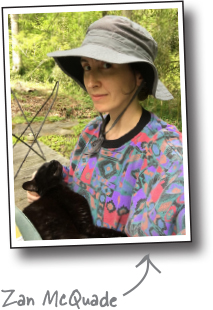
Family, friends, and colleagues:
Writing a Head First book is always a rollercoaster of a ride, and the third edition of this book has been no exception. Weâve truly valued the kindness and support of our family and friends along the way. Special thanks go to Mum, Dad, Rob, Lorraine, Mark, Laura, Andy, Aisha, Andy, Matti, Ian, Vanessa, Dawn, William, and Simon.
The without-whom list:
Our awesome technical review team worked hard to give us their thoughts on the book, keep us straight, and make sure that what we covered was spot on. Weâre also grateful to everyone who gave us feedback on the early release of this book, and the previous two editions. We think the bookâs much better as a result.
Finally, our thanks to Kathy Sierra and Bert Bates for creating this extraordinary series of books, teaching us to throw away the old rulebook, and letting us into their brains.
OâReilly Online Learning

For more than 40 years, OâReilly Media has provided technology and business training, knowledge, and insight to help companies succeed.
Our unique network of experts and innovators share their knowledge and expertise through books, articles, and our online learning platform. OâReillyâs online learning platform gives you on-demand access to live training courses, in-depth learning paths, interactive coding environments, and a vast collection of text and video from OâReilly and 200+ other publishers. For more information, visit http://oreilly.com.
Get Head First Android Development, 3rd Edition now with the O’Reilly learning platform.
O’Reilly members experience books, live events, courses curated by job role, and more from O’Reilly and nearly 200 top publishers.

